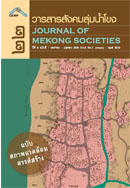The Life of Khon Kaen – Cognition or Morphology? Lessons from a Regional City of Thailand
Main Article Content
Abstract
The aim of this article is to ascertain the key factors, cognition or morphology of public spaces in making lively and diverse urban public spaces in the Thai context. It investigates spatial cognition as well as spatial configuration and the uses of public spaces of Khon Kaen, a regional city in Northeastern Thailand. The article starts with a brief history of Khon Kaen which led to its present roles in order to understand the city’s background. It then examines the city’s spatial cognitions, spatial configurations and the life of public spaces. The findings are as follows. Spatial configuration is a vital basic factor in making lively and diverse streets as well as nodes and places. Strong image elements are also associated with heavily used spaces although those elements do not have strong identity. However, there are some minor exceptions where nodes and places with very few users are along highly integrated routes. The reasons are varied; they are not in the daily uses of the people, but only sacred ones; they accommodate only necessary activities (Gehl, 1987); or they have security problems because of very few alternative routes and low visibility. Finally, the article provides suggestions and recommendations for the life of the city and for urban public spaces in general.

